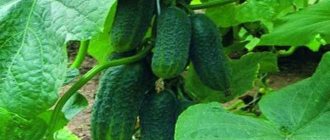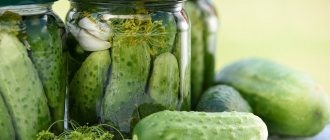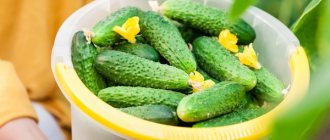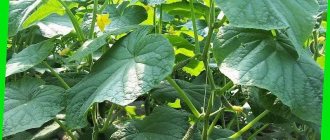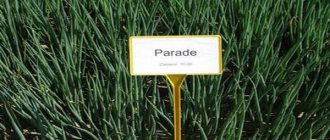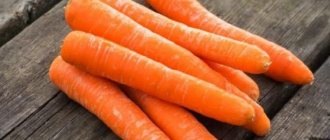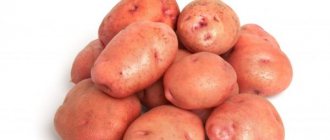Vegetable growing » Cucumbers
0
1799
Article rating
Kira Stoletova
Cucumbers are popular among gardeners. They are easy to grow even for a beginner. The main thing is timely care. The Satin cucumber variety is especially valued due to its high yield.
Characteristics of the cucumber variety Satina
The hybrid adapts to different conditions. Brings high quality fruits. Rich taste and bright green color are the advantages of the vegetable.
Characteristics of the variety
Hybrid cucumber Satina has an early ripening period. Cultivated in open ground, but it can be grown in a greenhouse. Vegetable crops have a generative type of pollination, that is, they are pollinated without the help of insects. Suitable for private and industrial cultivation.
Brief characteristics of the variety:
- resistant to temperature changes;
- grown in high beds;
- perfectly tolerates waterlogging and overdrying of the soil;
- fertilizing is carried out on demand.
Characterized by an average level of climbing. The beginning of fruiting is 35-40 days after the appearance of the first shoots.
Description of the bush
According to the description of the cucumber variety Satina, it has a female type of flowering. The type of ovary is bouquet. The height of the bush does not exceed 1.5 m. This is an indeterminate plant, that is, the flower ovary does not interfere with the growth of the main stem. Up to 6-8 fruits are formed on one bush.
The leaves of the hybrid are dark green and medium in size. The waviness of the edges is average to above average. Productivity is above average - 3.8-4.5 kg of cucumbers per 1 m2. But this is compensated by the excellent taste of the variety.
Description of fruits
Satin f1 cucumbers, reviews of which are very positive, have dark green fruits. The weight of greens is 80-110 g. Description of fruits:
- shape is smooth, cylindrical;
- pronounced pubescence;
- the spines are white;
- cucumbers Satin large-tuberous;
- short;
- The size of the fruits is approximately the same.
The skin of the vegetable is thin and dark green. Spotting is mild. There are white stripes 1-2 cm long. The flesh inside is crispy and tasty. There is no bitterness.
The Satina variety is unique. Cucumbers can be eaten fresh. They are used for preservation - pickling, salting. Satin makes excellent gherkins. They can be used to decorate a dish or add to a salad.
How to land
Cucumbers of this variety can be planted directly in open beds or first grown seedlings, which are then transplanted to a permanent place. Regardless of the planting method used, the hybrid takes root well in open ground and produces an excellent harvest.
If the seeds are immediately sown in the ground, then it is necessary to wait until the soil temperature is from 16 to 18 ° C. Before planting, the soil must be dug up and a complex of mineral substances added to it. Then you need to prepare the holes for the seeds and fill them with peat. It is better to sow in the evening, after sunset. In this case, the seeds should be placed at a depth of 1.5-2 cm, watered a little and covered with film. The film is removed after germination.
When using the seedling method, each seed must be grown in an individual container, since cucumber seedlings have a very fragile root system and do not tolerate replanting well.
Capacities:
- must be disinfected with a saturated solution of potassium permanganate;
- make small drainage holes in their bottoms to drain excess moisture.
Then the pots are filled with peat mixed with humus and rotted sawdust in equal parts and spilled with a hot solution of potassium permanganate to destroy pathogens contained in the soil. In the soil prepared in this way:
- seeds are placed at a depth of 1.5 cm;
- sprinkle them with soil;
- compact;
- water with settled water;
- cover with film;
- installed in a well-lit room.
The air temperature in this room should be from 25 to 27 °C.
As soon as the sprouts appear, it is necessary to move the containers to the windowsill and provide them with round-the-clock lighting during the first three days of life. As additional lighting, you can use special phytolamps.
Note!
Now the room temperature should be from 20 to 22 °C, otherwise the sprouts will elongate and become weak.
Water the seedlings with warm, settled water using a tablespoon or a shallow watering can as the top layer of soil dries out. You should not get carried away with watering so that the sprouts do not develop blackleg disease.
Each time after watering, the surface of the earth must be loosened. You should not go deep to avoid damaging the roots. But it is necessary to loosen it so that oxygen penetrates better into the soil and strengthens the immunity of the sprouts. In the middle of the seedling growth period and before transplanting to a permanent place, the greens should be fed with a special liquid fertilizer.
Growing
The variety does not need to be pollinated
The growing technology is elementary and no different from others. The main advantage is that the variety does not require pollination. The cucumber hybrid Satina is demanding only when it comes to soil. Medium loamy soil is suitable. This is due to good breathability. The best predecessors are onions, potatoes, peppers, cabbage.
Seed preparation
Before planting, you need to treat the seeds with a manganese solution. To do this, you need to dilute 1 gram of the product in 200 ml of water. Afterwards you need to soak the grains for no more than 20 minutes. Otherwise, they may rot. This procedure is needed to disinfect seeds. They will be less susceptible to the negative influence of pests and more resistant to diseases.
The price of 1 package of Satina f1 seeds is higher than the market average. But thanks to their excellent characteristics, gardeners do not refuse to buy them. After this, it is important to check the grains for defective ones.
As for the soil, it should also be treated with a solution of potassium permanganate. The ratio of product and water is 5 g per 10 l. It is necessary to remove weeds and loosen the soil.
Landing
Follow the planting pattern for cucumbers f1 - 60*15 cm in a greenhouse and 60*60 cm in open ground. Satin cucumbers are planted using a trellis method. Form rows 60-70 cm long. Organic fertilizers and mineral additives are required. The optimal distance between rows is 1-1.5 m. Trellis are placed in a row every 4 m. The height of the pillars is 2-2.5 m. Wire is pulled over them, onto which a 20*20 cm plastic mesh is attached.
The bushes begin to sprout from seedlings. Requirement: soil heated to 25-27 °C. In the case when the seeds are planted directly in the beds, the required ground temperature is 13-17 °C. The seed placement depth does not exceed 3 cm.
The optimal age of seedlings is 25 days. Focus on the number of leaves on the sprouts. There should be 2-3 of them. When more than 5 leaves appear, the plant is tied to a net. The vegetable crop is formed into 1 stem, all shoots are removed. This is necessary for the main shoot to germinate.
Transplantation and further care
A month after the sprouts appear, you need to transplant the cucumbers to a permanent place. At the same time, the temperature of the soil into which the plants will be transplanted should not be lower than 16 °C.
The ideal soil type for this cucumber variety is loamy. The main property of such soil is breathability, which is very important for the full development of cucumbers. Plants are planted in rows, the distance between which is 60 cm. Moreover, if planting is done in a greenhouse, then the distance between seedlings in one row is 15 cm, and if in open ground, then 60 cm. Rows should be made from 60 to 70 cm long.
The soil must be prepared first. It is necessary:
- dig up;
- apply complex mineral fertilizers.
After planting, the plants should be watered with settled water at room temperature, after which the seedlings should not be moistened or fed so that they can take root in a new place.
mulch with straw or sawdust
It is best to use a drip system for watering cucumbers. In this case, the plants will not lack moisture, but at the same time the humidity will not exceed the norm. After each watering, it is necessary to loosen the soil and weed the beds, since weeds take a lot of nutrients from the ground that could be used to feed cucumbers.
Cucumbers need to be fed three times during the entire growing season:
- During flowering. It is necessary to feed the plants with a complex of minerals with a predominant content of phosphorus and nitrogen.
- At the moment of fruit set. For feeding, organic matter is used, for example, cow manure, diluted with water in a ratio of 1 to 15.
- During fruiting. During this period, potassium salts are added to the fertilizing for faster fruit ripening.
When 5 to 7 leaves appear, the seedlings must be tied to a net, metal supports should be installed in each row at a distance of 4 m from each other and a wire should be stretched between them, to which a plastic net should be attached.
Note! To obtain maximum yield, plants must be formed into 1 stem, while removing all other shoots.
New shoots should be removed regularly every ten days.
If Satin F1 cucumbers grow poorly, then most often this indicates a lack or excess of moisture. Too wet soil is very harmful to the plant. With high humidity, the vines grow and fruiting stops. Signs by which it can be determined that a plant lacks one or another element are the following:
- If there is not enough nitrogen, the leaves first turn pale, then turn yellow and fall off.
- With a lack of phosphorus, the leaves darken, acquire a purple tint, and then turn black.
- Potassium deficiency leads to the fact that a border appears along the edge of the leaves, first light green, then it becomes brown and then brown, and spots appear in the center of the plate.
- When there is little calcium, this is expressed in weak growth, drooping and death of the tops.
- If the plant needs magnesium, then yellow spots appear on the leaves between the veins, and the leaves themselves turn brown and die.
- A lack of iron is expressed in the fact that the leaves acquire a light shade and then turn yellow, but do not fall off. The leaves at the top of the stem feel the worst.
- If there is not enough copper, then the tips of the leaves darken.
- With boron deficiency, the apical buds die, the leaves fall off, and flowering does not occur.
During the period of growth and fruiting of cucumbers, it is necessary to combat pests. To do this, you can, for example, treat the leaves and stems of plants with a soap solution prepared from a piece of laundry soap dissolved in a bucket of warm water.
Please note! To combat powdery mildew, special preparations are used, such as, for example, Immunocytophyte.
And some diseases are almost impossible to fight, but can be prevented. For example, in order to prevent root rot, it is necessary to ensure that the root collar of plants is not buried. She should be naked.
Diseases and illnesses
The advantage of Satin f1 cucumbers is resistance to diseases. But due to improper care, it can be susceptible to parasites.
Common diseases and pests:
- Bacteriosis occurs when soil moisture is excessive. The main symptom is white spots on the leaves.
- Olive spot is a fungal infection in the form of dark red ulcers along the entire length of the fruit. Spreads in high humidity and low temperatures.
- Cucumber mosaic - appears in the form of white and yellow spots. Found on both fruits and leaves.
Diseases can be eliminated by removing weeds and annual cleaning of the greenhouse. Once a year, change the top layer of soil (up to 10 cm) with a new one. Do not plant the plant in the same place for 2 years in a row. It is best to alternate cucumbers with tomatoes.
Technical description of the cucumber variety Satina
The author's description of cucumbers of the Satina variety states that the fruits are not dense enough, large-tubercular, and have pronounced white pubescence. And this is true. The weight of mature greens varies between 85 - 105 g. The even shape of the fruit and high taste increase consumer demand for this cucumber.
Regarding the yield indicators, the technical description of the Satina cucumber variety says that if agrotechnical rules are followed, it is possible to collect from 390 to 440 centners of vegetables from one hectare. Even at the beginning of the season, the crop yield is not small - a farmer can collect at least 110 centners of cucumbers from each hectare. Commercial products account for 96–98% of the total harvest.
Harvest and storage
The harvest is harvested in several stages. You can collect cucumbers 3–5 cm in size for “royal” pickles; specimens 5–7 cm in size are also tasty for pickling in barrels. Ordinary fruits, 10–12 cm long, have the same excellent taste and are used both for the table and for processing in various ways. Like any other cucumbers, these vegetables are unlikely to be stored for longer than 2-3 weeks.
In refrigerator conditions, dry storage and constant sorting of greens, you can extend their shelf life up to a month. The Satina variety is of interest to summer residents and farmers because, with high yields, it has excellent taste and attractive appearance. These cucumbers have only recently appeared in our country and are gradually gaining popularity.
Features of care
Bushes need timely and regular watering. The procedure should be carried out 4-6 times a week. It is necessary to water only with warm, settled water in the evening or in the morning before sunrise. Avoid getting water on the shoots and leaves of plants. For cucumbers, it is preferable to choose the drip irrigation method. This will distribute the moisture evenly.
For feeding, nutritional compositions containing nitrogen, potassium and phosphorus are used. During flowering and fruiting, this will be an indispensable procedure. Plants during this period need additional nutrition.
After watering, it is advisable to loosen the soil
This must be done with caution so as not to damage the roots of the bushes. Loosening will help saturate the root system with oxygen
Along with loosening and hilling, it is necessary to get rid of weeds in a timely manner. Weeds interfere with the full development of cucumbers, take away nutrients from the soil, and carry dangerous viruses.
Growing and caring for bunch cucumbers
The agricultural technology for cultivating bouquet-type cucumbers generally does not differ from standard technology. Basic techniques:
- watering;
- loosening and weeding;
- feeding;
- bush formation.
The indicators declared by the manufacturer in the description of the varieties (yield, number of greens) are achieved only if the basic recommendations are fully followed.
Features of cultivation:
- mandatory tying of plants to trellises. In open ground, it is convenient to use supports with a thin mesh mesh, to which the side lashes are tied;
- In the greenhouse and outdoors, plants should receive a large amount of light. With a lack of lighting, productivity drops sharply, the number of ovaries in the axils decreases;
- No more than 3 bushes are planted per square meter (preferably two plants);
- varieties of bunched cucumbers for open ground are planted on “warm” ridges (pillows of manure and compost are laid);
- select areas with loose, moisture-permeable soil;
- feeding - once every 8-10 days, in small doses. It is recommended to use complex formulations, as well as ready-made fertilizers (Ideal, Fertika, Kristalon).
Particular attention is paid to the formation of bushes of bunched cucumbers. “Bouquet” cucumbers are grown in one stem, with the side shoots pinched
It is necessary to form cucumbers in a greenhouse taking into account the zones; this is the only way to achieve the highest harvest rates of greens (see video).
Approximate diagram:
- zone “0” - up to 50 cm blinds all growth points. The leaf blades are not removed;
- zone “1” - up to a meter in height, leave lashes (15-20 cm), 1-2 leaf plates, one ovary;
- zone “2” - from a meter to one and a half meters. Pinch off, leaving a pair of ovaries, up to three leaves;
- zone “3” - leave 3 greens and three leaves on the shoots.
This pinching scheme ensures good illumination of the plants and uniform fruit production. Blinding the lower tier is necessary, since the crop is characterized by rapid growth and development, forms ovaries earlier than the fruiting period and therefore many of them can dry out. According to the scheme, it is easy to form a strong, abundantly fruiting plant, which is easy to care for.
On a note! Pinching is carried out in the morning so that the sections are tightened during the day. It is advisable to choose a clear day for work.
Bunch cucumbers are resistant to infections. But to increase immunity, preventive treatments are recommended at the beginning of the growing season (Bordeaux mixture, aqueous whey solution), as well as spraying with Zircon or Epin (before budding).
The greens are removed daily, or at least once every two days. If it is impossible to collect regularly, slow-growing hybrids are chosen for planting, which gradually form a harvest. Gherkins of the “bouquet” type do not outgrow and do not lose their taste when picked unsystematically, but the overall yield from the bush decreases.
Advantages and Disadvantages of Culture
Satin F1 cucumber is good in the garden and on the table. The hybrid is suitable for collecting pickles and gherkins. It is used for fresh eating, pickling, etc. This is not the only advantage of cucumbers:
- Productivity is high. At the same time, the yield of fruits of commercial quality is 95-98%. Cucumbers are straight and beautiful to look at, and can withstand transportation well over long distances.
- Great taste. There is no bitterness.
- Weather unpretentiousness. Cucumber bears fruit at its level even in unfavorable conditions and copes with short-term drought or waterlogging.
- Early ripening (38-40 days). A gardener can remove up to 1.1 kg/sq.m. in the initial ten days of fruiting. m.
- Resistance to certain diseases.
Attention! The cucumber has one obvious disadvantage. There will not be many fruits without strict adherence to technology.
